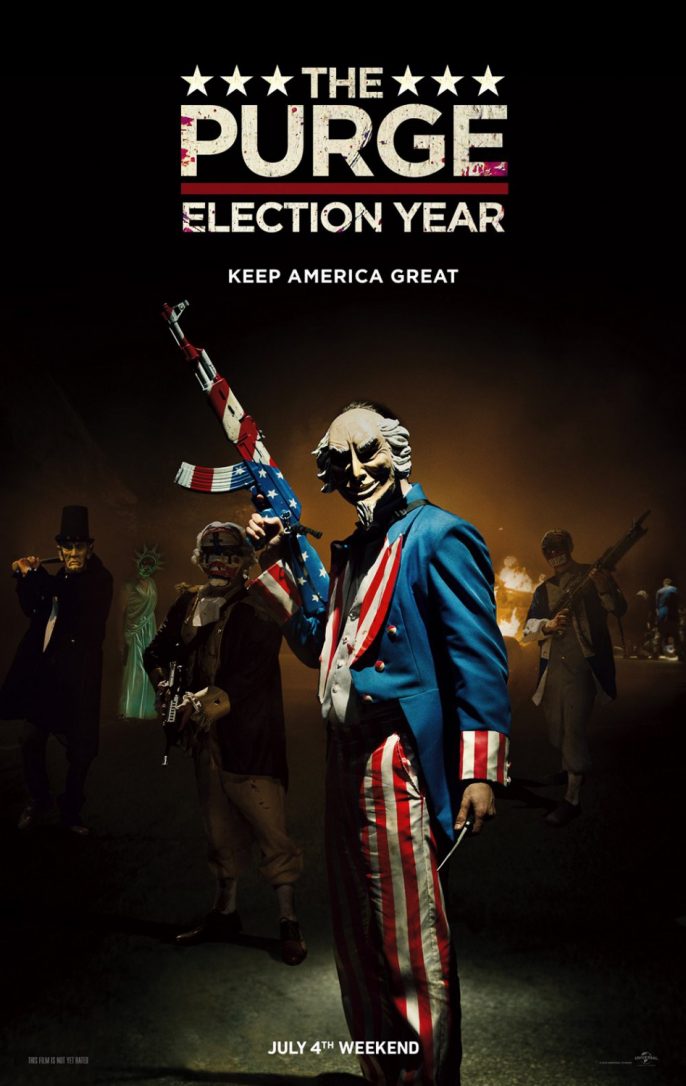An unspecified amount of time after The Purge: Anarchy, Leo (Frank Grillo) is working as head of a security team guarding independent presidential candidate Senator Charlie Roan (Elizabeth Mitchell). Roan has based her campaign around opposing the annual Purge, a cause that Leo can get behind — or in front of, if he has to take a bullet for her.
It turns out that not only Leo has relocated from Los Angeles to Washington DC; coincidentally, so has the heretofore unnamed “bloody stranger” (Edwin Hodge) from The Purge and The Purge: Anarchy, who we find out is named Dante Bishop. In Election Year, he seems to serve the same function as Carmelo in Anarchy: spokesperson for an underground band of (largely minority) rebels against the New Founding Fathers of America (NFFA).
The day before this year’s Purge, the NFFA revokes the rule that government officials of high stature are exempt from being killed — ostensibly to disprove Dante’s claim that the Purge is a way for the elitist NFFA members to kill off the ranks of the poor while they remain safe in their ivory towers. In truth, the rule was nixed so the NFFA could hatch a plot to bump off Roan.
Leo thwarts the assassination attempt but finds himself leading Roan on the run through the streets of DC on Purge night, where he finds help from shopkeeper Joe (Mykelti Williamson) and his workers, Laney (Betty Gabriel, pre-Get Out) and Marcos (Joseph Julian Soria), who try to help them survive until dawn.
The Purge: Election Year is the weakest of the first three films in the series — with the antics of the wacko Purgers starting to feel a bit self-indulgent — but it’s not without its merits. The mythology of the Purge experience expands in wild and glorious ways to include elements that are both imaginative and frighteningly reflective of what might actually happen if the Purge became reality — from Purge insurance to victim disposal services (minus the Monty Python “Bring out your dead” shtick) to amateur ambulances and “murder tourists” from other countries coming to the US to enjoy this uniquely American experience.
Perhaps most striking about Election Year, though, is that it’s the most unapologetically, socio-politically militant of the three films — no doubt reflecting the atmosphere surrounding Donald Trump’s election campaign. While the original film merely inferred a racial slant to the Purge, the third has the NFFA employing outright white nationalists to do their bidding. The portrayals of the all-white, virtually all-male NFFA members are over-the-top, as they literally worship the Purge like a religious cult, practically drape themselves in the American flag and revel in their one-percent status, declaring “Some can NOT have,” because there’s “not enough to go around.” It’s enough to make a red state see red.
In its haste to make a statement, however, Election Year fails to generate the emotional resonance of the previous movies — the second in particular. Roan’s grief at losing her family during the Purge as a child is glossed over, and it ends up feeling more preachy than its predecessors.
Plus, unlike the first two films, it features not one, but TWO instances of the black character “heroic death” cliché — courtesy of Dante and Joe, the latter of whom literally jumps in front of Senator Roan to take a bullet. Still, despite its faults, with a bar as high as the first two Purges set, third place isn’t such a bad spot.
